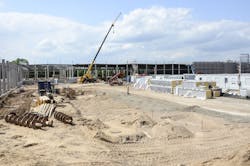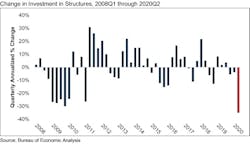Construction Output Takes Sharp Drop Due to COVID-19
The U.S. economy contracted at an annualized rate of 32.9% during the second quarter of 2020, according to an Associated Builders and Contractors analysis of data recently released by the U.S. Bureau of Economic Analysis. Nonresidential and residential fixed investment contracted by 27.0 and 38.7%, respectively, while investment in nonresidential fixed structures contracted by 34.9% (see Table and Chart below). Statistically, the decline in national output is attributable to multiple factors, including significant declines in personal consumption, exports and private inventory investment.
“Despite construction’s status as an essential industry in most cities and states, the sector did not escape the wrath of COVID-19 during the worst economic quarter on record,” said ABC Chief Economist Anirban Basu. “ABC’s Construction Confidence Index indicates that a majority of contractors suffered some form of interruption to their activities during the second quarter, whether due to a lack of available inputs as global supply chains buckled, project postponements or cancellations, job-site workforce issues or state and local government mandates.”
Although retail and hospitality markets obviously took a hit in Q2, Basu explained why construction activity has continued to decline.
“A number of key construction segments like office, lodging and commercial were hit especially hard by the pandemic. Many contractors in these segments maintain an ostensibly healthy level of backlog, according to ABC’s Construction Backlog Indicator, but the possibility of outright cancellation remains elevated as obtaining project financing becomes more challenging and vacant office and retail space accumulates. While May and June represented periods of robust economic bounce back in terms of employment, retail sales, building permits and manufacturing activity, recovery will become more erratic over the next several months. That will further delay construction’s eventual rebound, including in segments that are likely to be significant contributors to construction spending growth in the future, such as data centers, fulfillment centers, health care and manufacturing.”


